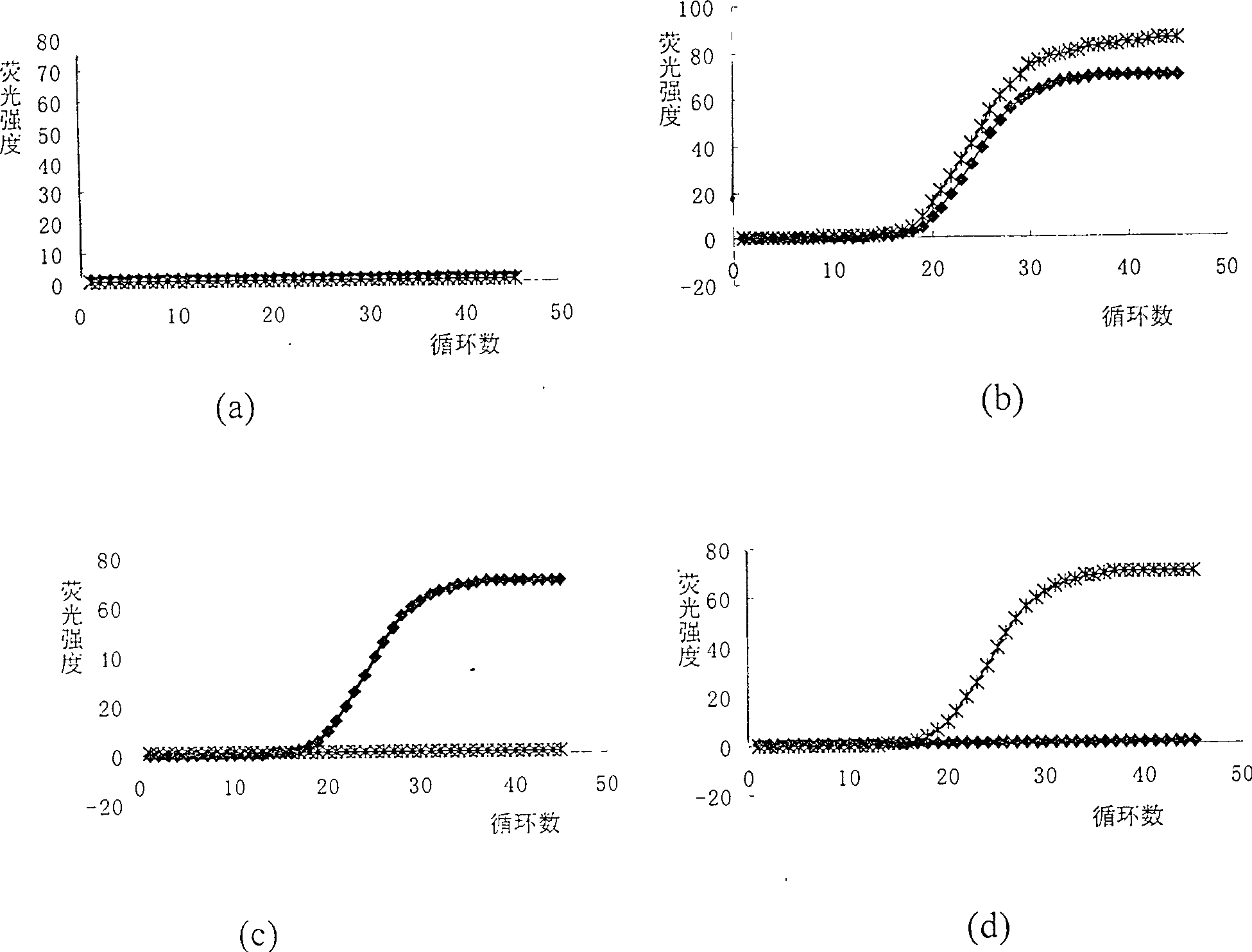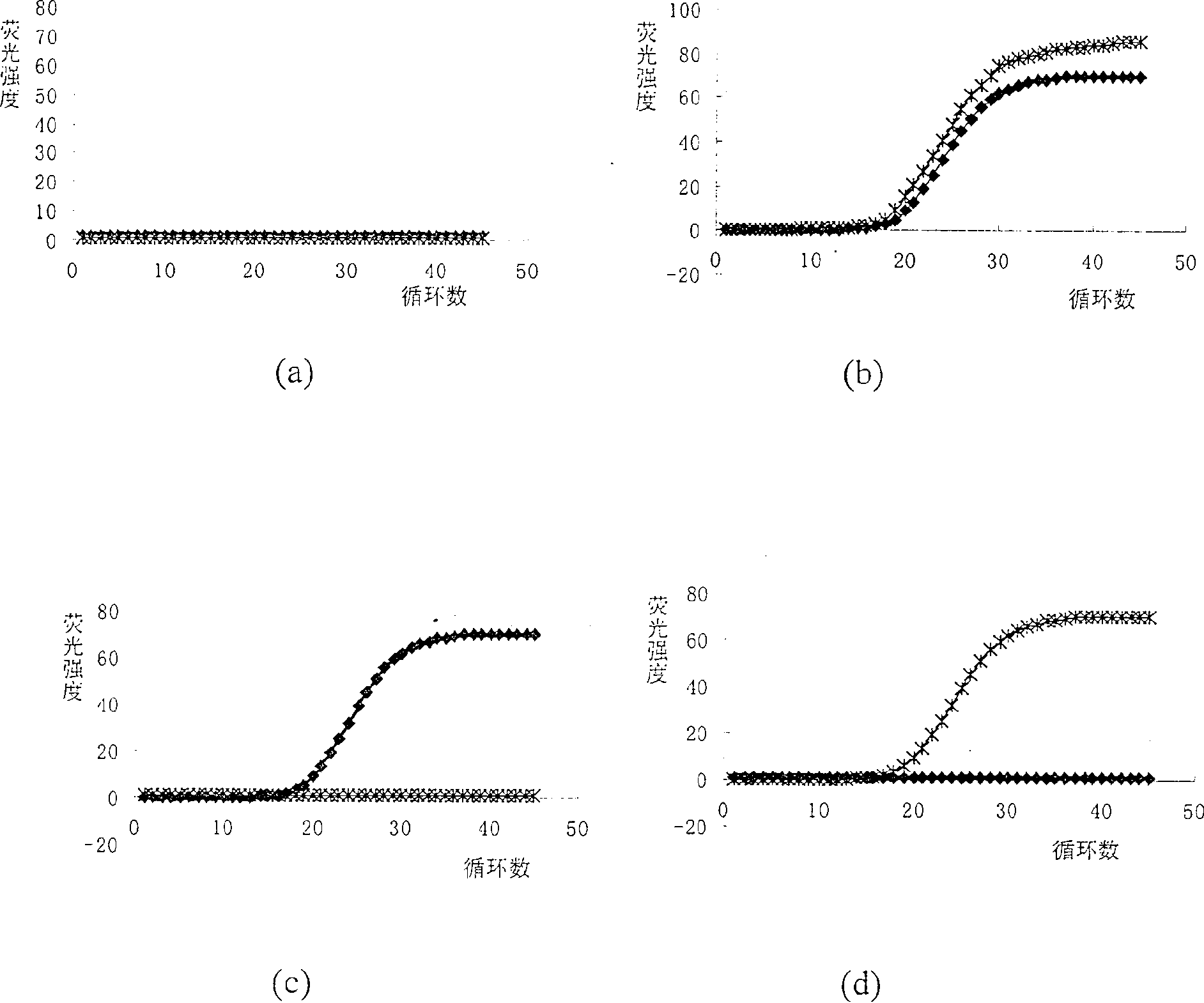Method of duplex fluorescence PCR - improved molecule beacon for detecting pathogenesis bacterium stemmed from eating source
A technology for improving molecular beacons and food-borne pathogenic bacteria, applied in biochemical equipment and methods, and microbial measurement/inspection, etc., can solve the problem of cumbersome operations and the inability to quickly detect multiple food-borne pathogens at the same time , time-consuming and other problems, to achieve the effect of simple operation, intuitive and clear result observation, and high sensitivity
- Summary
- Abstract
- Description
- Claims
- Application Information
AI Technical Summary
Problems solved by technology
Method used
Image
Examples
example 1
[0084] In this example, the detection of Vibrio cholerae and Vibrio parahaemolyticus by dual fluorescent PCR-modified molecular beacon is taken as an example. According to the sequence of Vibrio cholerae enterotoxin gene (ctxA) and Vibrio parahaemolyticus thermostable direct hemolysin gene (TDH) sequence published by GenBank and comparative analysis, a pair of primers and probes were designed respectively.
[0085] Primer 1 and probe 1 of ctxA gene
[0086] ctxA-F: 5′-TCCGGAGCATAGAGCTTGGA-3′,
[0087] ctxA-R: 5′-TCGATGATCTTGGAGCATTCC-3′
[0088] ctxA-Probe:
[0089] HEX-5′- CCGTGGATTCATCATGCACCGCC ACGG-3'Dabcyl,
[0090] Primer 2 and probe 2 of TDH gene
[0091] TDH-F: 5'-AAACATCTGCTTTTGAGCTTCCA-3',
[0092] TDH-L: 5′-CTCGAACAACAAACAATATCTCATCATCAG-3′,
[0093] TDH-Prcbe:
[0094] FAM5′-CCGGGG TGTCCCTTTTTCCTGCCCCCGG -Dabcyl,
[0095] Test strains: 104 strains of 12 kinds of bacteria. Including 1 strain of Salmonella (Salmonella), 1 strain of Shigella (Shigella), 5 ...
example 2
[0124] A pair of primers and probes were designed according to the sequences of Salmonella invasion gene (ivnA) and Shigella invasion plasmid antigen H gene (ipaH) published by GenBank and comparative analysis.
[0125] Primer 1 for invA gene:
[0126] invA-F: 5'-GCGGAATATC(I)ATGACGCAGCT-3'
[0127] invA-L: 5'-CGCTACGTTTTGCTTCACGG-3'
[0128] Probe 1 for the invA gene:
[0129] 5'-FAM-CCG CCATTTGTATTGGTTGTTACGGC GG-DABCYL-3'
[0130] Primer 2 for ipaH gene:
[0131] ipaH-F: 5'-TGAAGGAAATGCGTTTCTATG-3'
[0132] ipaH-L: 5'-AGGGAGAACCAGTCCGTAAA-3'
[0133] Probe 2 of ipaH gene:
[0134] ROX5'-CACG GCCGAAGCTATGGTCAGAAGCCGTG -3'-DABCYL
[0135] Reagent components: 10×PCR buffer, MgCl 2 , Taq enzymes, and dNTPs were purchased from Dalian Bao Biological Company, China.
[0136] Test strains: 132 strains of 14 kinds of bacteria. Including 1 strain of enterotoxigenic E. coli (ETEC), 1 strain of invasive E. coli (EIEC), 1 strain of O157: H7 E. coli (O157: H7), 1 strain of ...
example 3
[0159] A pair of primers and probes were designed according to the sequences of the thermostable nuclease gene (NUC) of Staphylococcus aureus and the hemolysin gene (hly) of Listeria monocytogenes published by GenBank and comparative analysis.
[0160] A pair of primers for NUC gene 1:
[0161] NUC-F: 5'-GGCAATACGCAAAGAGGTT-3'
[0162] NUC-L: 5'-CTTCTTCTATTTACGCCGTTATC-3'
[0163] Probe 1 for NUC gene:
[0164] ROX-5'-CGATGCA GTCTAAGTAGCTCAGCAAATGCATC G-3’-DABCYL
[0165] A pair of primers for the hly gene 2:
[0166] hly-F: 5'-TGCAAGTCCTAAGACGCCA-3'
[0167] hly-L: 5'—CACTGCATCTCCGTGGTATACTAA—3'
[0168] Probe 2 of hly gene:
[0169] FAM-5'-CGCG CTTGTATATACTTATCGATTTCATCCGCGCG -3'-DABCYL
[0170] Reagent components: 10×PCR buffer, MgCl 2 , Taq enzyme, and dNTP were purchased from Dalian Bao Biological Company.
[0171] Test strains: 85 strains of 13 kinds of bacteria. Including 1 strain of Salmonella (Salmonella), 1 strain of Shigella (Shigella), 1 strain of Vib...
PUM
 Login to View More
Login to View More Abstract
Description
Claims
Application Information
 Login to View More
Login to View More - R&D
- Intellectual Property
- Life Sciences
- Materials
- Tech Scout
- Unparalleled Data Quality
- Higher Quality Content
- 60% Fewer Hallucinations
Browse by: Latest US Patents, China's latest patents, Technical Efficacy Thesaurus, Application Domain, Technology Topic, Popular Technical Reports.
© 2025 PatSnap. All rights reserved.Legal|Privacy policy|Modern Slavery Act Transparency Statement|Sitemap|About US| Contact US: help@patsnap.com



